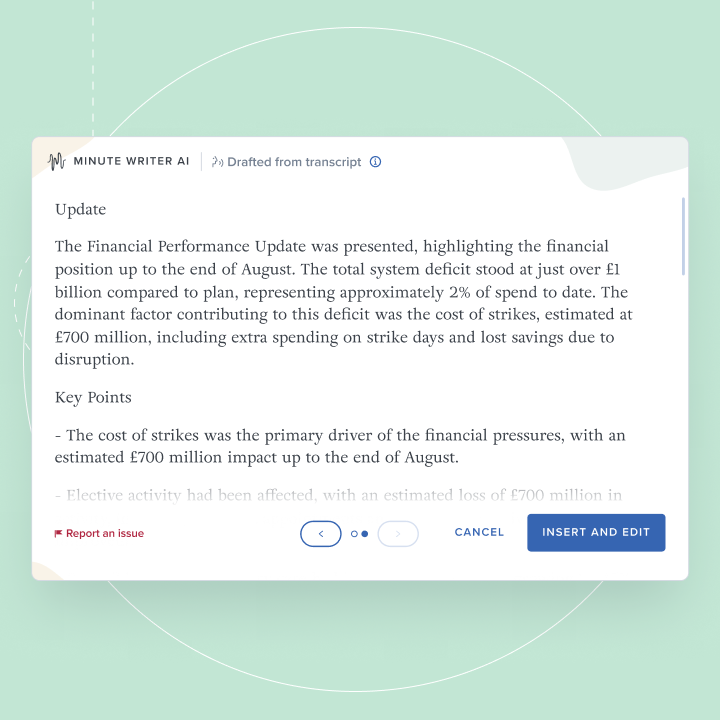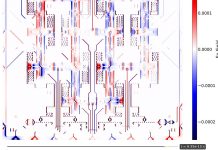Board effectiveness experts Board Intelligence explore the role of AI in minute writing
High-quality board meeting minutes are vital to good governance but take considerable skill, time, and effort. Writing board and committee minutes costs the average organisation nearly £1m per year in time alone.
With the UK Government’s AI Opportunities Action Plan challenging those working within government to consider AI as ‘core to how we think about… improving productivity’, minute writing seems like an obvious candidate for AI-powered productivity gains. But how exactly do AI tools ease the minute writing burden? And how can you be confident you’re using the right tool for the job?
What can AI minute writing tools do?
AI is particularly good at summarising text, spotting patterns in information, and automating repetitive manual tasks, so the technology is well suited to minute writing. For example, AI tools can record and transcribe discussions at the click of a button. When integrated into a board portal, they can build a template for each meeting’s minutes based on its agenda and tailored to the forum’s focus and needs – turning a task that typically takes an hour into one that can be done in seconds.
AI tools can also convert digital notes, transcripts, and templates into properly formatted minutes. This might mean putting the words in the correct tense, recording decisions and actions, tidying up grammar and syntax, defining terms and using appropriate acronyms, and applying the organisation’s house style.
 What are the potential benefits of using AI for board meeting minutes?
What are the potential benefits of using AI for board meeting minutes?
Delivering best practice minutes comes at significant monetary and opportunity cost. As one governance professional told us, “The amount of time we spend on this is enormous; I have to do it on a Sunday evening because there’s just not enough time to do it justice during the week. It’s unsustainable.” That’s because meeting minutes are critical for good governance. They’re the definitive record of board and committee meetings, so they must be accurate, timely, and written in the right tone. They need to reflect the nuances of discussions to meet legal requirements while being easy to scan for key decisions and actions. This delicate balance – coupled with the sheer volume of meetings that require minuting – is why they dominate governance and administration teams’ workloads. Data we’ve gathered from 140 governance teams shows that it takes ten hours to produce a high-quality set of meeting minutes for the average board or committee meeting. That equates to between two and five hours of work for every hour of meeting time.
By using AI to automate or speed up elements of the minute writing process, governance teams can deliver high-quality minutes much more efficiently – and spend more time on the aspects of their work that add the greatest value.
What are the key considerations when using AI for minute writing?
Let’s be clear: AI minute writing tools cannot be used to automate the entire process. The final step – the sense check required before minutes are circulated and approved – takes skill, knowledge, and judgement. This isn’t just because of concerns about privacy and data security or the reliability of recording and transcription tools (which, although improving, often struggle with technical language, accents, and poor sound quality, for example). It’s also because AI minute writing tools vary; they don’t all tackle the problem in the same way, or with the same quality.
Generic transcription tools, for example, aren’t designed to deliver the specific requirements of board and committee meeting minutes or deal with the volume of information that these meetings generate.
Before building our AI-powered minute-writing tool, Minute Writer, we tested some general-purpose generative AI tools using publicly available content. At first, we were impressed. But looking more closely, we saw that important details were missing – things like the headline figure on financial performance, for example, that a company secretary wouldn’t overlook. Sentences had been lifted from the tool’s ‘memory’ and inserted into the minutes when there was no evidence of them in the transcript. The quality dropped as the meeting progressed, usually about halfway through the transcript (at around 40,000 words).
These errors made it clear that generic tools would not meet the needs of governance teams, boards or regulators and that a purpose-built tool was required. The key to developing such a tool would be to ensure AI was applied to the right tasks and, secondly, to structure the tool to perform one task at a time rather than trying to do everything in a single step (something called ‘multi-step prompting’). It also demanded multiple checks and balances – sense checks that would ensure users owned the output throughout the process to be confident in the minutes they were producing.
Should governance teams use AI for meeting minutes?
With increasing support from central government to ‘move fast and learn things’ and ‘Scan > Pilot > Scale’ AI tools to improve productivity, it would be tempting to try and automate minute writing away altogether.
Best practice minutes, which satisfy both boards’ and regulators’ needs while being efficient to produce, might be a step too far for some AI tools, particularly generic ones. But, if built with governance teams’ needs in mind and used with caution, they are a powerful enabler of governance teams and an essential tool for good governance.
Find out more about AI minute writing
You can find further guidance on best practice minute writing and board AI trends on Board Intelligence’s website, where you can also request a personalised demonstration of Minute Writer, the AI-powered tool which is halving the time governance teams spend on minute writing
Minute Writer from Board Intelligence
- Secure, purpose-built AI that’s been specifically developed for creating high-quality meeting minutes
- Turn notes or transcripts into ready-to-go, formatted minutes
- Save hours and budget on administrative tasks











